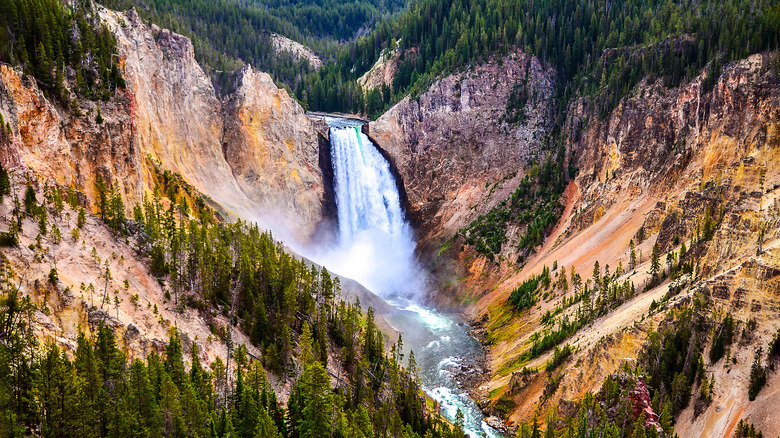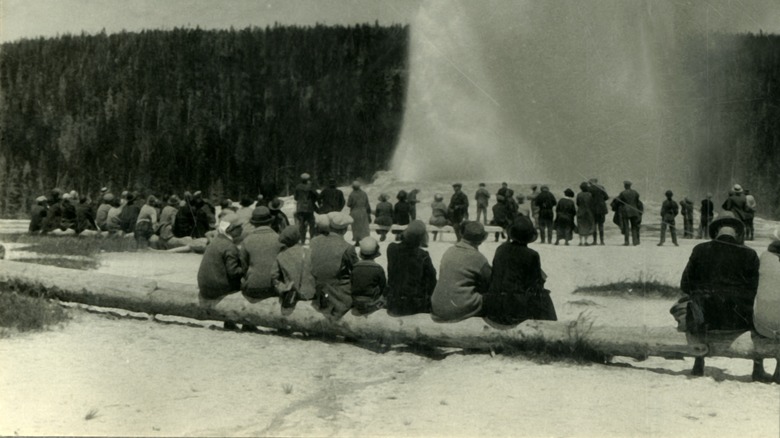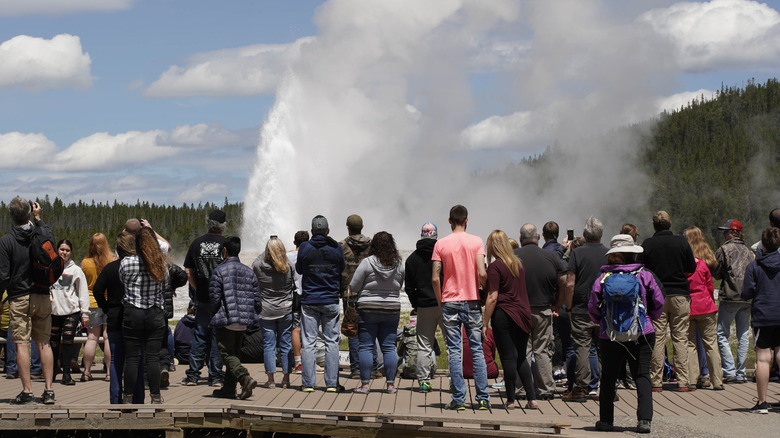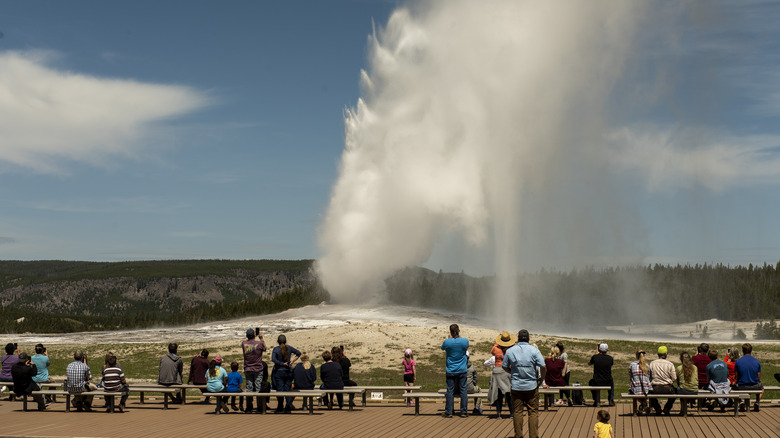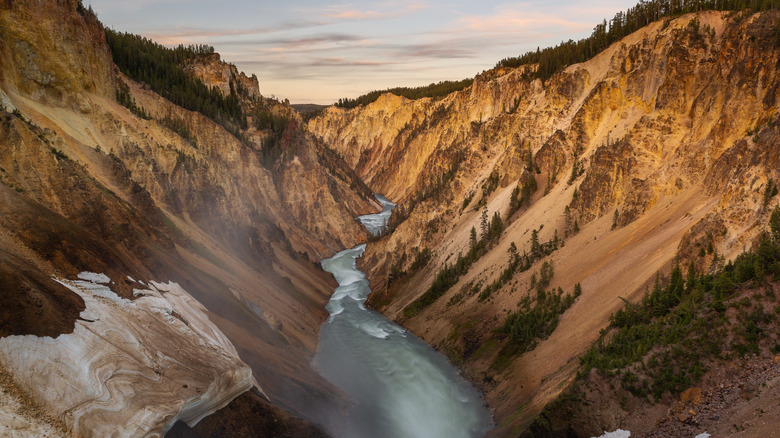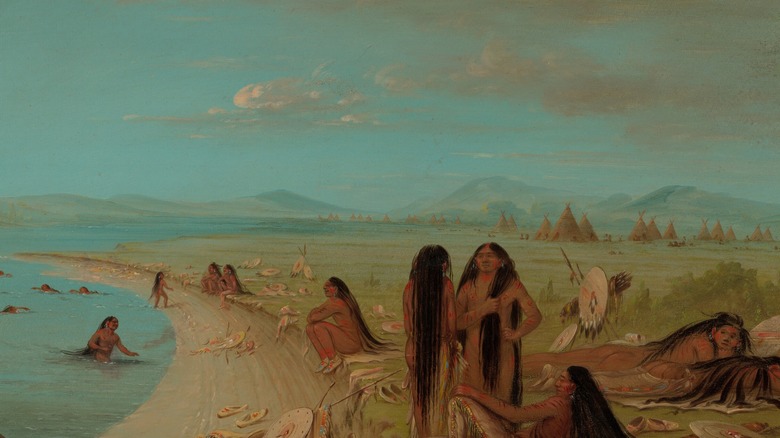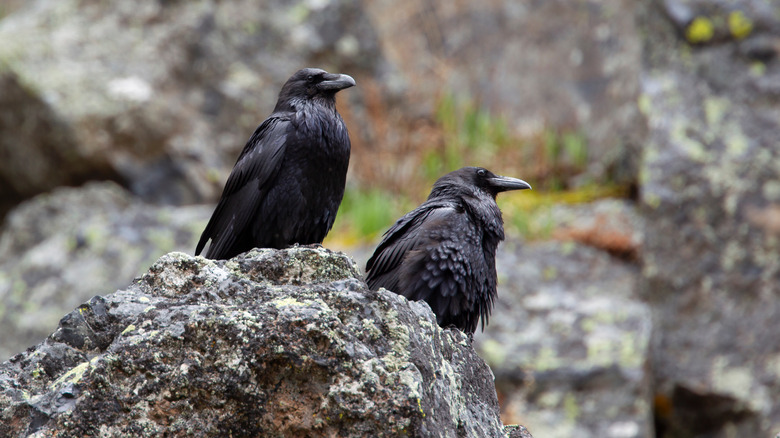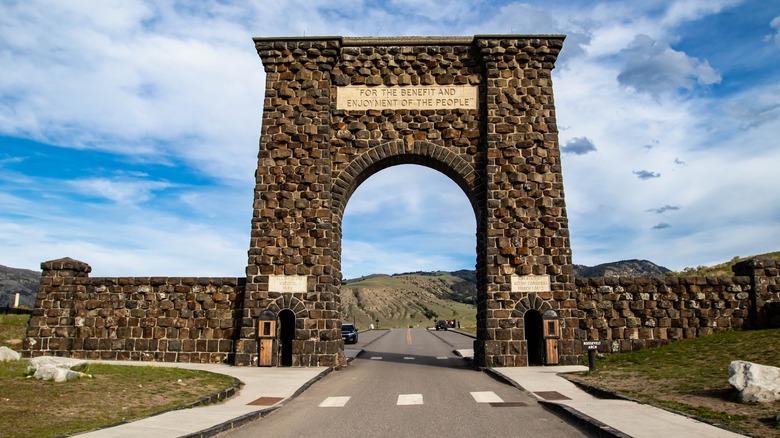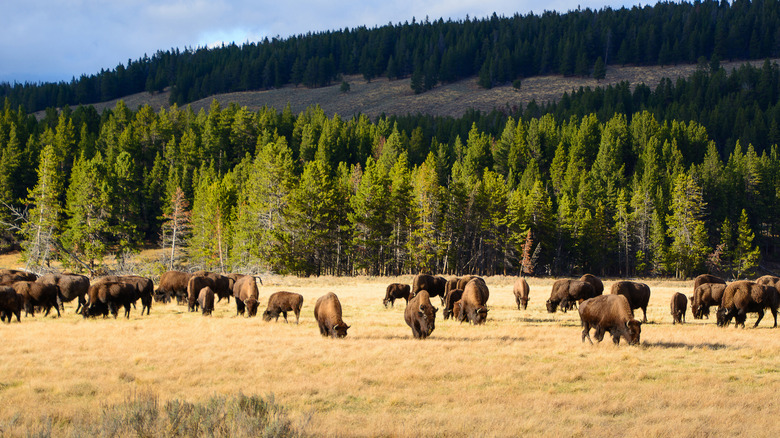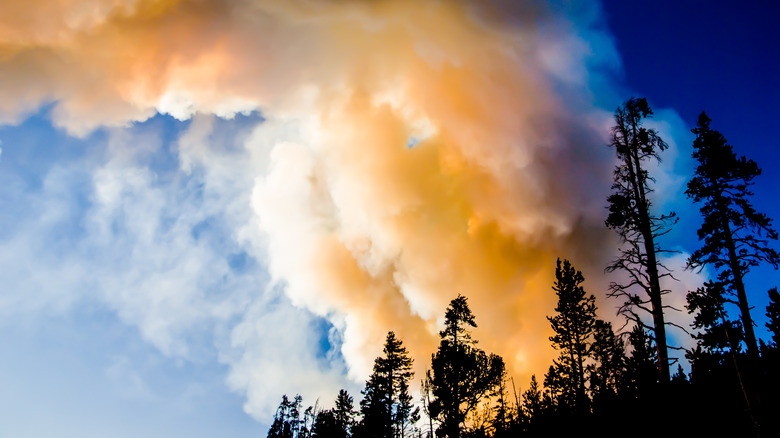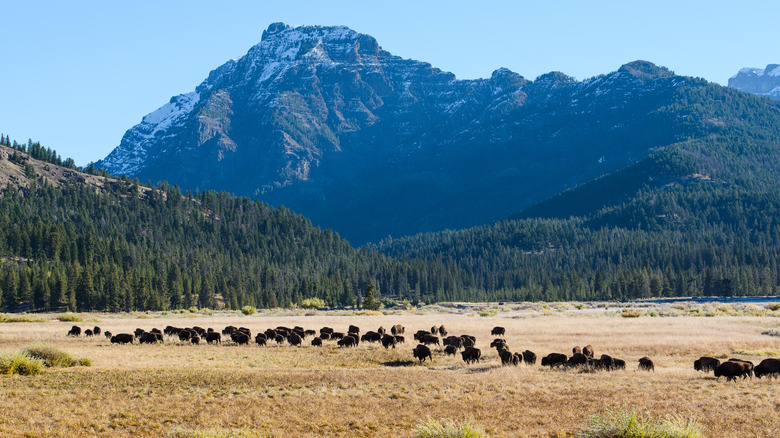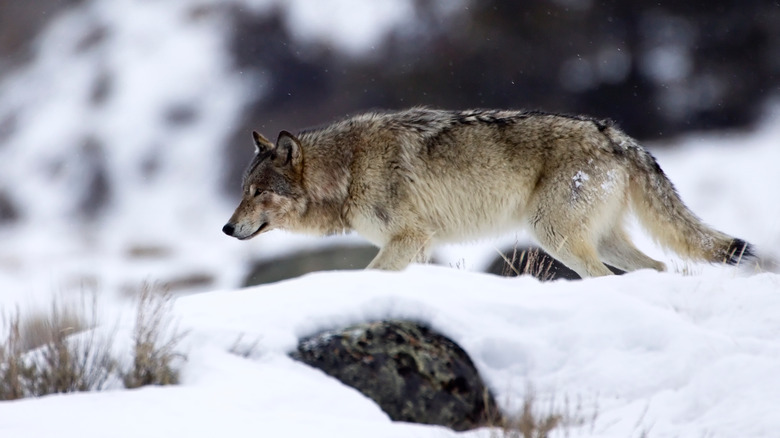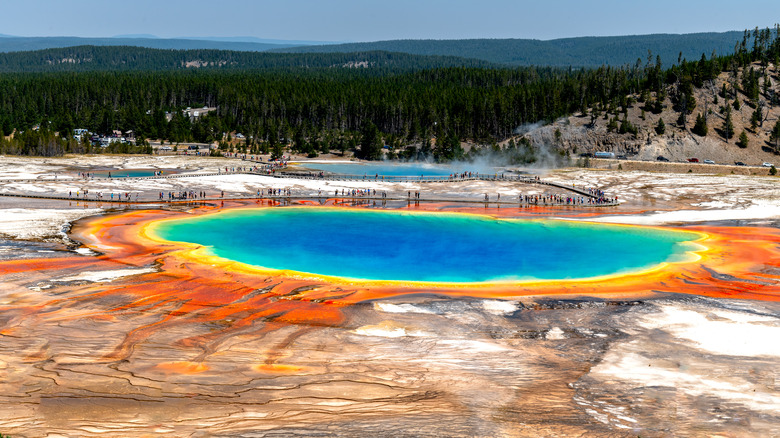The Untold Truth Of Yellowstone National Park
Formed in 1872, according to the National Park Service, Yellowstone National Park is a land bound by snow-capped mountains, filled with forests, cliffs, wildlife, exotic plants, and, of course, boasting a huge number of geysers and other iconic hydrothermal features due to the presence of a mighty magma chamber bubbling just beneath the surface.
Given all these natural wonders, it's no surprise the place is such a beloved destination for sightseers, hikers, campers, nature lovers, and tourists of all kinds, from every corner of the planet. But anywhere that spans 2.2 million acres across three U.S. states is going to house a lot of secrets. From obsidian cliffs to earthquakes to ancient civilizations, a potentially world-ending supervolcano, and a legally dubious region where you can (theoretically) get away with just about anything, there are plenty of fascinating facts about this breathtaking wilderness. This is the untold truth of Yellowstone National Park.
Yellowstone was the first national park in the world
Life Magazine has the details on how Yellowstone became America's first national park. In a nutshell, the Northern Pacific Railroad Company was planning to lay tracks in Montana, not too far from modern-day Yellowstone. Believing tourism would be a huge boost to the economy in the region, they lobbied Congress for an 1870 expedition, which produced headline-grabbing reports of the natural beauty of Yellowstone. Two years later, the Yellowstone Park Act was passed, placing the park under the jurisdiction of the U.S. Department of the Interior, and thus out of the claws of private interest. Yet it was a profit-hungry corporation that successfully sought to have the park protected from, well, profit-hungry corporations, just so it could benefit from tourism. And, as the National Park Service explains, the world's first national park was created.
Yep — national parks did not exist before 1872. Natural reserves did, according to the article, as did state parks like Yosemite. But the concept of federally protecting a piece of land because its natural beauty was deemed too precious to commercially exploit was a new concept. It's a good thing the park spans three states, too — the NPS says that's what prevented it from becoming another state park.
More than half the world's geysers are in Yellowstone
Old Faithful might be the first thing you think of when you hear the name Yellowstone. But it's far from the only geyser there. The National Park Service says that the place is filled quite literally to bursting with geysers. So many, in fact, that it has more (roughly 500 throughout the park) than anywhere else on earth. Actually, let's rephrase that. It has more geysers than the rest of the planet combined. Yes, you read that right: more than half of Earth's geysers are in Yellowstone, due to massive amounts of volcanic activity rumbling beneath the park's surface and constant resulting minor earthquakes, which prevent the geyser-producing cracks and vents in the earth's surface from being sealed with mineral crystallization (per Britannica).
But geysers are only one type of hydrothermal feature to be found in Yellowstone. NPS says that the constantly shifting, rumbling earth also makes hot springs (the most common hydrothermal feature by far, created when rainwater seeps through the earth's surface and gets superheated by subsurface volcanic gasses), mudpots (pooled rainwater heated by rising steam), fumaroles (also known as steam vents), and travertine terraces (limestone transformed to look like an inside-out cave by rising thermal water and heat-loving organisms).
In fact, geysers — formed when rising, heated water is prevented from reaching the surface by some form of natural congestion, thus producing towering jets of water — are the rarest hydrothermal feature there is.
Old Faithful is a little less faithful than you think
Yellowstone National Park might just be the world's number one destination for people who love getting lost in nature. It's a truly massive, majestic place, filled with mountains, forests, wild animals, vast, open steppes, lakes, rivers, and everything else outdoorsy types could possibly want. And yet, you could bet a pretty decent amount of money that well over half the Yellowstone postcards ever made have the unmistakable image of Old Faithful on it.
Easily the world's most famous geyser, Old Faithful got its name because it spouts huge jets of boiling water into the sky at very regular intervals. Go to see it, which you almost certainly are planning to if you're visiting the park, and there's just about a 100% chance of witnessing one of its famous, wicked cool 130+ foot eruptions.
That all being said, it isn't entirely faithful. As is the case with other geysers, the period between Old Faithful's eruptions has gradually lengthened over time, according to the U.S. Geological Survey, from 60-70 minutes when it was first discovered in the 1870s to its current 77-78 minute interval today. Furthermore, Live Science says that the interval period can be affected by everything from rainfall to earthquakes. Despite all that, it probably doesn't deserve to be docked so many points that it loses its name.
Yellowstone has its own Grand Canyon
Okay, it's not quite as grand as the Grand Canyon you're no doubt more familiar with, but then again, nothing is. And the Grand Canyon of the Yellowstone is still pretty dang breathtaking. The National Park Service has the details.
Formed after the last Yellowstone supervolcano eruption some 630,000 years ago, the park's Grand Canyon features layer upon layer of different colored rocks: an amazing opportunity for researchers to study the area's rich and ancient geological history. For casual hikers, the views of vast distances and multiple waterfalls, plunging as much as 308 feet to the floor below, should be worth the trip. Plus, there's always a chance you'll get to see birds of prey, notably Ospreys, doing what they do when they're not cooped up in a zoo.
Still not convinced the 20-mile-long, 1,000-foot-deep, 1,500 to 4,000-foot-wide yawning chasm is worth at least an afternoon's detour to check out? The article quotes explorer Nathaniel P. Langford saying in 1870, when he first laid eyes on the feature, that the sight of it made him contemplate his "own littleness, my helplessness, my dread exposure to destruction, my inability to cope with or even comprehend the mighty architecture of nature..." Sounds like it earns the title "grand," even if it could've been a bit more creative with the name.
Humans have lived in Yellowstone for more than 11,000 years
When they reached what's now known as Yellowstone National Park on their famous expedition west, explorers Lewis and Clark didn't discover the gorgeous mountains, wildlife, and geysers. The National Park Service says they were actually quite late to the party: human beings were already there.
Turns out, people had been hanging around Yellowstone for roughly 11,000 years, meaning the first people arrived well before the earliest known historical records. For reference, that makes the earliest Yellowstone societies twice as ancient to the Ancient Babylonians as the Ancient Babylonians are to us. And for literally thousands of years, these societies were relatively stable, able to adapt to a slowly changing but usually favorable climate that provided food and other resources in relative abundance.
In the early 19th century, after contact with European and American settlers, things began to change. Another National Park Service article details how first explorers like Lewis and Clark, then frontiersmen, fur trappers, and gold hunters made their way west. They brought gunpowder, new cultures and languages, and, as is always the case when discussing Europeans or Americans showing up somewhere for the first time, lots and lots of trouble for indigenous peoples who'd been living in the area for millennia. Eventually, they would bring the long arm of the law, in the form of the expanding United States government.
Yellowstone has an Obsidian Cliff
No, it's not some kind of magical, spooky black metal like you'd find in an RPG. But Yellowstone's Obsidian Cliff is still very, very cool. According to the National Park Service, the cliff, a historic landmark as of 1996, was formed by lava that cooled without crystallizing, producing a thin, dark glass-like material. Of course, Yellowstone is filled with volcanic activity, so you'd be correct in guessing that obsidian can be found throughout the park. But whereas most obsidian takes the form of tiny rocks, this one, as the name suggests, is an entire cliff — with 98 feet of exposed vertical thickness.
And it's not just cool to look at, either. Humans have a long and storied history with the cliff. The infamous 1988 Yellowstone wildfire swept the cliffside clear of foliage, allowing researchers to better study its features. They discovered that humans began mining obsidian from the mountainside almost as soon as they arrived in the region 11,000 years ago. They crafted all sorts of things from the stuff. Another National Park Service article says its sharp, solid qualities made obsidian especially useful for toolmaking among early hunter-gatherer societies. Obsidian artifacts later determined to be from the cliff spread far and wide, too – making up as much as 90% of the obsidian found in Hopewell tradition mortuary sites throughout the Ohio River Valley, all the way in the American Midwest.
There are more than 1,000 protected manmade structures in Yellowstone
When you think of Yellowstone, or any National Park, really, you probably think of untamed wilderness, teeming with wildlife, covered in flourishing plants, hiding secrets ranging from insect species you can't find anywhere else on earth, to the remote peaks of distant, snow-capped mountains. You probably aren't thinking of humans, beyond campers and the occasional ranger outpost. But Yellowstone has been sparsely inhabited and frequently visited for a long time now. And humans tend to leave behind things that can stick around a long time, especially if they enjoy special protected status as historical sites.
As the NPS points out, the story of people in Yellowstone is part of the park's legacy. Today, more than 1,000 manmade structures and sites are protected. These range from various bridges any hikers will need to safely navigate the park, to rural villages, to the Old Faithful Inn (yes, you can stay for days in Yellowstone without having to pitch a tent), to Roosevelt Arch, and even small residential areas. Some protected sites are parade grounds, landscaped parks, or cemeteries. You can even visit the Fishing Bridge, Madison, and Norris Museums inside the park, the Northeast Entrance Station, Lake Hotel, and Fort Yellowstone. Luckily, the buildings here are all required to maintain a "rustic" appearance and some semblance of historic character. So don't worry about your view of Old Faithful getting ruined by a Burger King in the background.
You can get probably away with murder in the Zone of Death
Hopefully you don't ever find yourself in this situation, but if you absolutely had to, um, dispatch someone, where's the best spot? The answer is Yellowstone, but not for the reasons you're thinking. Yes, you're in the middle of nowhere, so you probably won't get caught in the act. But even if you got filmed doing the dastardly deed, there's still a chance you might get away with it — assuming you committed the crime in the part of the park that's in Idaho, known as the "Zone of Death."
It's never happened, thankfully. But as Vox points out, the hypothetical defendant need only invoke their Sixth Amendment right to be tried by a jury of their peers from the state and federal district in which the crime was committed. But the state of Wyoming has jurisdiction over the entirety of Yellowstone (even though a tiny percentage of the park is in Montana and Idaho). Plus, nobody lives in the part of Yellowstone that's in Idaho but governed by Wyoming. Therefore, no such jury could be convened, preventing a trial or any consequences whatsoever. (People do live in the Montana portion of Yellowstone, so be careful).
You shouldn't blame the Founding Fathers for not thinking of this when they drafted the Constitution, but is it too much to ask that Congress pass a bill handing this 50-mile sliver of Idaho to Idaho, in order to prevent this?
Wildfires are par for the course in Yellowstone
The National Park Service says that forest fires are routine and necessary in Yellowstone, just like they are in nature at large. As the article points out, the fires have a cleansing, purifying effect, leveling the natural playing field and allowing surviving species of plant and animal life to thrive when the smoke clears. This produces what the article describes as a "mosaic" of plant communities, growing at their own pace, which is vital for maintaining a robust and vibrant environment.
Fires, often started by lightning strikes in dry areas, also impact the natural cycles that move nutrients through the ecosystem. For the most part, the fires are small, burning themselves out after a short time and without causing much damage. But the arrival of Europeans greatly influenced this, as settlers sought to control the conflagrations as much as they could. While this helped certain animals and plants survive, it did disrupt the natural cycle that shapes the local environment.
Still, there's an obvious benefit to controlling the largest fires. In 1988, an infamous one scorched more than a million acres after spreading beyond the borders of the park, defying the best efforts of authorities to rein it in. As climate change worsens and summer news becomes increasingly filled with headlines about out-of-control super-fires, it's unlikely this problem will go away on its own, or any time soon.
Yellowstone is an earthquake magnet
Unless you live in California, Japan, or somewhere else along the edge of earth's major, always-shifting tectonic plates, you've probably experienced no more than one or two earthquakes in your entire life. But if you live in Yellowstone National Park, situated atop a gigantic magma chamber that produces more than half the world's geysers and similar geothermic features, earthquakes are simply a fact of life. The National Park Service says the park has experienced between 700 and 3,000 earthquakes since they started keeping records, which is-
Wait. Sorry. Make that 700 to 3,000 earthquakes every single year. That's a minimum of two earthquakes and as many as eight or nine per day, every day, for thousands of years straight. The article actually uses the terrifying term "swarms" to describe bunched-up quakes that routinely occur in a specific place and time, due to the park's countless faults, vents, geysers, assorted tectonic features, and the constant flow of magma between chambers.
Luckily, though, visitors to the park don't spend the whole time getting ragdolled off cliffs and into boiling waterspouts. The quakes aren't all 8 or 9 on the Richter scale; most are merely minor rumblings that the article says keep what it calls the underground "plumbing" system open. Without quakes, mineral deposition would set in and seal off the park's many breathtaking geysers. Plus, the frequency of earthquakes here allows researchers to better map out and understand the unique subsurface geology beneath their feet.
Reintroducing wolves had a huge effect on biodiversity in the park
On January 12, 1995, Yellowstone Park says eight gray wolves, imported from Jasper National Park in Alberta, were dropped off by a van in Yellowstone. They were the first of their species in the park since they'd been hunted to local extinction between 1872 and 1926. Now, authorities were bringing them back to rebalance the park's ecosystem, which had been decimated by the out-of-control spread of elk.
Of course, eight wolves might not sound like enough to control a ballooning population of overgrazing deer, who had all but eradicated the shrubbery that countless small animals called home. But the wolves multiplied. In the years since, the gray wolf population has fluctuated between 83 and 108 wolves – organized into eight distinct packs – and has done a terrific job of culling the elk population. Without an overabundance of deer, the plants they feed on – and the animals that live in and depend on them – have roared back to life. By introducing a deadly predator to the Yellowstone ecosystem, the park had actually increased the quantity and quality of wildlife to be found.
Of course, the measure wasn't without controversy. Local farmers continue to worry that the wolves will either wander off the range and target their livestock, or overcorrect the elk problem by hunting them to extinction. But so far, although concerns remain, the wolves have had an enormous and, most would agree, positive, impact on Yellowstone's biodiversity.
A Yellowstone supervolcano eruption could mean the end of mankind
BBC Science Focus Magazine did some homework on what would happen if the Yellowstone Caldera – the titanic supervolcano lying dormant beneath the park – erupted. As you might've guessed simply by noting the scale of Yellowstone's geothermal activity and the presence of the word "supervolcano" in that last sentence, it's nothing good. In fact, it would almost certainly be the most cataclysmic natural disaster in recorded history.
The article predicts that in the lead-up to an explosion, the park would experience months of escalating earthquakes as the gigantic magma chamber rumbled to life. The final mega-quake would coincide with the 875-megaton explosion, producing a shockwave that would instantly kill 90,000 people. Most of the lava would either fall back into the crater or stop flowing 40-50km from the epicenter, but humanity's troubles would just be getting started. Soon, gigantic ash clouds would flow outwards in all directions, burying the surrounding states like snow and tossing "200 million tons of sulfur dioxide ... into the stratosphere," blotting out the sun and triggering a decade-long climate cooling period.
While it'd be nice to not have to worry about global warming for once, a global volcanic winter that demolishes crop yields and plunges the surviving population into a lung-cancer-filled famine is probably not the way to go. Fortunately, Vox says the likelihood of such a super-eruption occurring any time in the next few centuries is smaller than that of a killer asteroid smashing into Earth.
